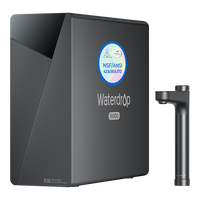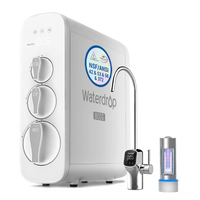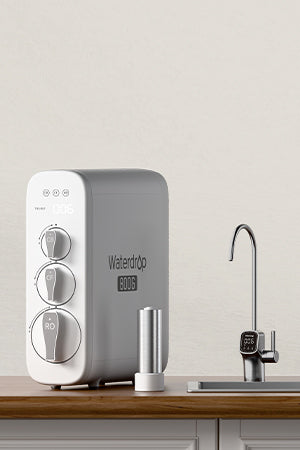Michigan is a state that is heavily dependent on the auto industry. The great recession of the automobile industry at the end of the last century still dimmed the lights of the Greater Detroit area, and the
2008 financial crisis was another strike to the state. City Flint is also inevitable.
Flint Water Crisis Background
From 2011 to 2015, the city of Flint filed bankruptcy liquidation (receivership). Governor Rick Snyder assigned different emergency managers to take over Flint's municipality. One of the job duties of the emergency officer is to reduce government expenditures and save the government from the financial crisis.
On April 25, 2014, as
a cost-saving move, the City of Flint decided not to purchase Lake Huron water from Detroit, but instead fetch water from the local Flint River. However, because the water pipes in the United States have been covered with lead before, the water of the new flint river and the surface protective layer of the lead water pipe reacted. Eventually led to a series of health problems and diseases, and a water crisis broke out.
Flint Water Crisis Timeline
After the water source was switched, residents of Flint City immediately noticed that the color, taste, and smell of the water were abnormal. Local residents developed rashes, hair loss, epilepsy, and other symptoms one after another, and then the children were diagnosed with anemia.
In August 2014, excessive Escherichia coli was detected in drinking water in Flint, and the Michigan Department of Environmental Quality advised residents to boil before drinking.
In January 2015, local resident Lee-Anne Walters asked the City of Flint to test the yellowish-brown water flowing from her tap. The results showed that the lead content in her water was far exceeding the standard. But the City of Flint still believes that Flint's water is safe, and the water quality of Anne Walters's house is just an example.
In March 2015, the Flint City Council decided to suspend the use of the Flint River as a water source and switch back to purchasing water from Detroit, but Flint's on-duty emergency officer Jerry Ambrose dismissed the city council. Resolution and reaffirmed that Flint’s water meets EPA standards.
In August 2015, a study by Professor Marc Edwards of Virginia Tech confirmed that the lead in Flint's water exceeded the standard.
On October 2, 2015, the Mayor of Flint, Dayne Walling, held a press conference to acknowledge the water pollution incident.
On October 21, 2015, Michigan Governor Rick Snyder formed the "Flint Water Supply Advisory Group" to start solving the water crisis.
On January 5, 2016, Michigan Governor Rick Snyder declared a state of emergency in Genesee County, where the city of Flint is located, and made a public apology for the crisis for the first time.
On January 16, 2016, US President Barack Obama declared Flint a state of federal emergency and allocated US$5 million for rescue.
On March 27, 2017, the federal judge approved a significant deal to replace water lines in Flint homes.
The crisis continues with numerous lawsuits against the state government and water regulators.
On the 10th of November, 2021. According to reports from the Associated Press and BBC, a federal judge approved a US$626 million settlement agreement for victims of the lead water pollution case in Flint, Michigan from 2014 to 2015.
The compensation funds will be used for children who have drunk poisoned water in the city, affected adults, business owners, and anyone who pays water bills. Except for attorney fees, about 80% of the remaining will be spent on children.
Health Impacts of Lead in Drinking Water
Adults who drink lead-containing water will have symptoms such as fatigue, kidney deficiency, and anemia. If the human body is exposed to lead for a long time, symptoms such as heart failure will occur. Learn more on
Make Your Water Lead-Free With These Proven Tips.
Compared with adults, lead pollution is more harmful to children and pregnant women. Drinking water with excessive lead can lead to abnormal behaviors such as inattention, grumpiness, and aggressive behavior in children. It can also lead to irreversible consequences such as premature delivery or even miscarriage of pregnant women.
Lead can also cause damage to multiple organs and multiple systems in children, and the damage to the brain is even irreversible for life. When Lead accumulates in children, it can easily damage the nerve and endocrine system, and lead to children's mental retardation and growth retardation. As lead damage increases and time passes, these diseases will be further aggravated.
Solutions to The Flint Water Crisis
When facing a water crisis like Flint, there are two recommendations to ensure water safety and secured access to clean water.
Bottled Water
Bottled water is a secured water source during a water crisis. It is one of the easiest solutions to access clean water nowadays. The common choices for bottled water include purified bottled water and mineral bottled water.
Purified water is water that has been purified through an industrial water treatment system or water treatment plant. Mineral water is water that is fetched from natural water sources, like glacier water or spring water. The famous Evian water, for example, is water collected from natural springs around the French Alps.
During the Flint water crisis, residents rely heavily on bottled water as their main source of water. However, bottled water is not the ultimate solution. The high cost of bottled water and the
environmental pollution caused by disposable plastic bottles are limitations that need to be aware of.
Water Filter System
To help prevent plastic pollution while saving money, a water filter system is considered to be the best solution during a water crisis. For serious water problems like Flint had been through, the reverse osmosis system is the ideal choice for the finest filtration accuracy.
Under Sink Tankless Reverse Osmosis Water Filter
The flow of water is from a low concentration to a high concentration. Once the water is pressurized, it will flow from a high concentration to a low concentration, which is the so-called reverse osmosis situation. The pore size of the RO membrane is one-millionth of the hair (about 0.0001 micrometers), which is generally invisible to the naked eye. Learn more on
What Is a Reverse Osmosis System and How Does It Work.
The size of bacteria and viruses is 1000 times larger than the pore size of a RO membrane. Therefore, only water molecules and some mineral ions can pass through the membrane, and other impurities and heavy metals are discharged from the waste water pipe.
The Waterdrop D6 reverse osmosis water filter is one of the latest reverse osmosis systems on the market. It features a modern tankless design to save your under sink space as well as composite filters for easy installation and replacement.
The system adopts a 5-in-1 composite reverse osmosis filter with the advanced RO membrane that can reduce most of harmful contaminants from water, including TDS, chloramine, lead, chlorine, salt, nitrates, PFAS, lead, sodium, chromium, benzene, etc.
The 600 GPD flow rate can meet your daily water use, saving a lot of effort and time. Besides, there is a smart stylish faucet included in the package, indicating the water TDS value in real-time.
Countertop Reverse Osmosis Water Filter
As the name suggests, a countertop reverse osmosis water filter is an RO system that is placed on the top of a counter.
The Waterdrop N1 RO system is a popular choice for its excellent filtration performance and minimum energy consumption. Unlike the under sink systems that need to be installed and connected to water lines, the N1 system can be placed anywhere with an electrical socket.
The system adopts an advanced RO membrane and UV light that can be utilized to kill bacteria, viruses, lead, heavy metals and more contaminants on an hourly basis. Check more Best Waterdrop Tankless RO Water Filters if you are interested.






































































